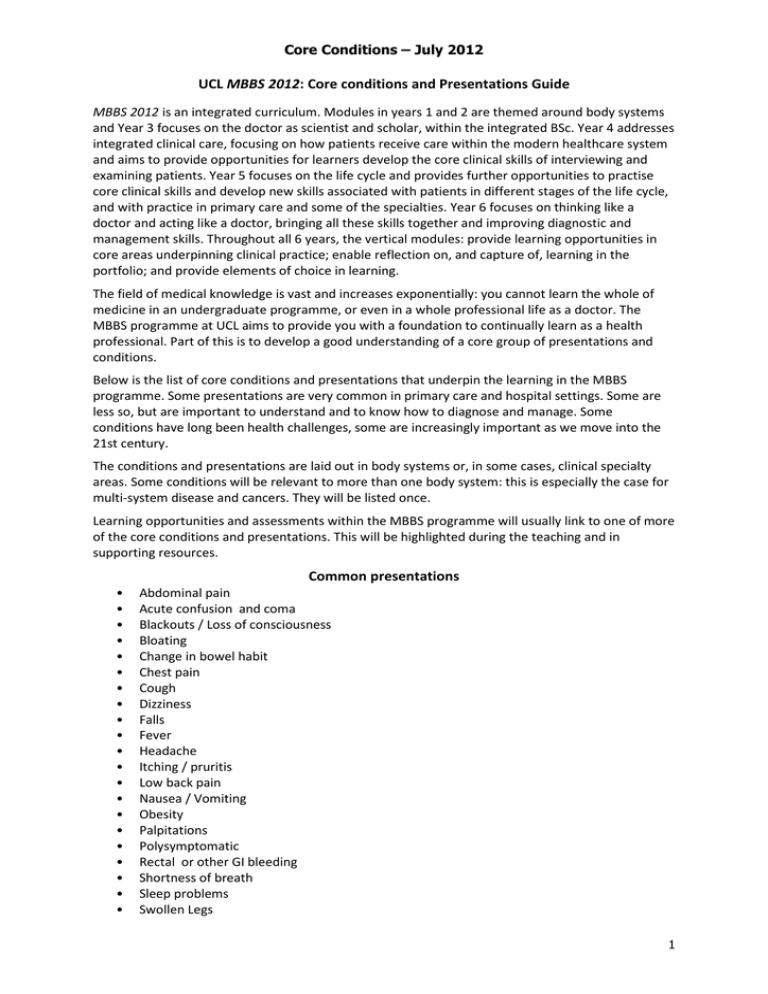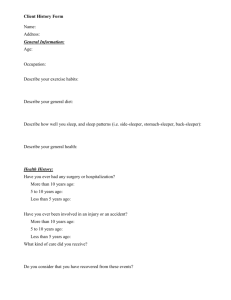MBBS 2012
advertisement

Core Conditions – July 2012 UCL MBBS 2012: Core conditions and Presentations Guide MBBS 2012 is an integrated curriculum. Modules in years 1 and 2 are themed around body systems and Year 3 focuses on the doctor as scientist and scholar, within the integrated BSc. Year 4 addresses integrated clinical care, focusing on how patients receive care within the modern healthcare system and aims to provide opportunities for learners develop the core clinical skills of interviewing and examining patients. Year 5 focuses on the life cycle and provides further opportunities to practise core clinical skills and develop new skills associated with patients in different stages of the life cycle, and with practice in primary care and some of the specialties. Year 6 focuses on thinking like a doctor and acting like a doctor, bringing all these skills together and improving diagnostic and management skills. Throughout all 6 years, the vertical modules: provide learning opportunities in core areas underpinning clinical practice; enable reflection on, and capture of, learning in the portfolio; and provide elements of choice in learning. The field of medical knowledge is vast and increases exponentially: you cannot learn the whole of medicine in an undergraduate programme, or even in a whole professional life as a doctor. The MBBS programme at UCL aims to provide you with a foundation to continually learn as a health professional. Part of this is to develop a good understanding of a core group of presentations and conditions. Below is the list of core conditions and presentations that underpin the learning in the MBBS programme. Some presentations are very common in primary care and hospital settings. Some are less so, but are important to understand and to know how to diagnose and manage. Some conditions have long been health challenges, some are increasingly important as we move into the 21st century. The conditions and presentations are laid out in body systems or, in some cases, clinical specialty areas. Some conditions will be relevant to more than one body system: this is especially the case for multi-system disease and cancers. They will be listed once. Learning opportunities and assessments within the MBBS programme will usually link to one of more of the core conditions and presentations. This will be highlighted during the teaching and in supporting resources. • • • • • • • • • • • • • • • • • • • • • Common presentations Abdominal pain Acute confusion and coma Blackouts / Loss of consciousness Bloating Change in bowel habit Chest pain Cough Dizziness Falls Fever Headache Itching / pruritis Low back pain Nausea / Vomiting Obesity Palpitations Polysymptomatic Rectal or other GI bleeding Shortness of breath Sleep problems Swollen Legs 1 Core Conditions – July 2012 • • • • Tired all the time Urinary symptoms Weight loss Wheeze • • • • • • Breast Head and neck Larynx Metastatic cancer - Bone, Liver, Brain Prostate Testes • • • • • • • • • • • • • • • • • • • • • • • • • • • • • • • Autism, Aspergers & ADHD Birth asphyxia Bronchiolitis Cerebral palsy Coeliac disease Congenital heart defects - VSD and patent ductus Croup Cystic fibrosis Developmental delay Developmental dysplasia of the hip Down syndrome Failure to thrive / Faltering growth Febrile convulsions Gastro-oesophageal reflux disease Henoch-Schonlein purpura Immune thrombocytopaenia Infantile colic Infantile hypertrophic pyloric stenosis Inherited disorders of metabolism Intussusception Kawasaki disease Neonatal jaundice Neuroblastoma Normal development and puberty Pre-term infants Respiratory distress syndrome/Hyaline membrane disease Rickets Separation anxiety / school refusal Transient synovitis Turner syndrome Wilms tumour Cancers (if not included elsewhere) Child health Circulation and breathing • • • • • • • Arrythmias - atrial fibrillation, flutter, nodal tachycardia, ventricular ectopics, tachycardia, fibrillation first, second & third degree (complete) heart block Asthma Blood vessel disorders (aneursyms, varicose veins, peripheral arterial disease, atherosclerosis) Chronic obstructive pulmonary disease including Bronchiectasis Heart failure and its consequences Hypertension Interstitial lung disease 2 Core Conditions – July 2012 • • • • • • • • • • Ischaemic heart disease Pericarditis & tamponade Pleural effusion Pneumothorax Respiratory cancers Respiratory failure: type 1 and 2 SVC Obstruction Thromboembolism - arterial and venous Upper and lower respiratory tract infections including infections in immune-compromised patients Valvular heart disease including infective endocarditis Endocrine system regulation and Reproduction and Genetics • • • • • • • • • • • • Adrenocortical insufficiency and excess Diabetes mellitus Type 1 and type 2 Diabetic emergencies: ketoacidosis, hypo and hyper glycaemia, hyperosmolar non-ketotic coma Disorders of calcium metabolism Endocrine emergencies: Addisonian crisis, thyrotoxicosis, myxoedema, phaeochromocytoma, pituitary failure Gonadal dysgenesis Lipid metabolism disorders Metabolic syndrome Pituitary and adrenal tumours SIADH and diabetes insipidus Thyroid cancer Thyroid dysfunction: hyperthyroidism, hypothyroidism, goitre Ear nose and throat • • • • • • • • • • • • • • Acoustic neuroma Acute vertigo/ Meniere's disease Cholesteoma Epistaxis Facial palsy Hearing loss Obstructive sleep apnoea Otitis Media and Externa Otosclerosis Pleomorphic salivary adenoma Presbyacusis Rhinitis Safe perforations Salivary gland disorders • • • • • • • • • • Alcoholic liver disease Anal conditions – abscess, haemorrhoids, fistula, fissure Cancers of the bowel, stomach, oesophagus, liver and pancreas Diverticular disease Enteropathies and malabsorbtion, Functional disorders of the GI tract Gallstone disease GI bleeding GORD / Dysphagia Hepatitis, cirrhosis, drug related liver injury and metabolic liver disease Gastroenterology 3 Core Conditions – July 2012 • • • • • • • Infection and infestations of the GI tract Inflammatory Bowel Disease Jaundice Obstruction Oesophagitis / Barrett’s oesophagus Pancreatic disorders - pancreatitis, insufficiency Ulcers – peptic and duodenal • • • • • • • • • • Anticoagulation Bleeding disorders: thrombocytopenia; DIC; haemophilia Blood transfusion Haematological malignancies: lymphoma; leukaemia; myeloma Haemolysis including haemoglobinopathies Iron deficiency Megaloblastic anaemia Neutropaenic sepsis Polycythaemia Thrombophilia Haematology Infection and Defence • • • • • • • • • • • • Bone and joint infection: osteomyelitis, septic arthritis of joints, TB CNS infections: meningitis; encephalitis; abscess; infections in the immunocompromised ENT infections Genitourinary infections: syphilis; gonorrhoea, chlamydia Hepatobiliary infections HIV Imported fevers including malaria Septic shock Tuberculosis Urinary tract infection and pyelonephritis Vaccination Viral hepatitis Kidneys & urinary tract • • • • • • • • • • • • • • Acute kidney injury Acute nephritic syndrome Bladder and urothelium cancers Chronic kidney disease Diabetic nephropathy Glomerulonephritis Hypertension & the kidney Kidney cancer Microscopic haematuria Nephrotic syndrome Prostatic hypertrophy Renal replacement therapy Upper urinary tract obstruction, hydronephrosis Vesicoureteric reflux and nephropathy • • Bone cancers Common disorders and injuries of the hip, knee, ankle, foot, neck, back, shoulder, elbow, wrist and hand Common fractures of upper and lower limbs including principles of treatment Compartment syndrome • • Movement and musculoskeletal biology 4 Core Conditions – July 2012 • • • • • • • • • • • • • • • • • • • Connective tissue disorders including SLE Gout & pseudogout Inflammatory arthropathies including RA Management of spinal injuries Metabolic bone disease e.g. Paget's, osteoporosis and Vitamin D Osteoarthritis Rehabilitation after joint replacement, fractures or severe injuries, especially spinal injuries Seronegative arthritis Mental health Alcohol and substance misuse Anxiety including generalised anxiety disorder, phobias, PTSD and OCD Deliberate self harm and assessment of suicide risk Eating disorders : anorexia and bulimia nervosa Mental health problems in people with learning disabilities Mood (affective) disorders including depression and bipolar disorder Personality disorders Post-partum mental health disorders Psychoses, and schizophrenia Sexual dysfunction Somatoform disorders including somatisation and hypochondriacal disorder Neuroscience and behaviour • • • • • • • • • • • • • • • • • Cerebrovascular disease including TIAs, intracerebral thrombosis and haemorrhage Cranial nerve lesions Dementias - vascular, Alzheimer's, Lewy Body Functional neurological disorders Guillain Barre syndrome Intracranial and spinal tumours Migraine Motor neurone disease Multiple sclerosis Myaesthenia gravis Myopathies Nerve root and cauda equina compression Organic causes of psychiatric disorders Parkinson's disease Peripheral and autonomic neuropathy Seizure disorders Spinal cord compression Ophthalmology • • • • • • • • • Cataracts Causes of acute and gradual visual loss Children and the eye Diabetes and the eye Eye in systemic disease Glaucoma Neurophthalmology – diplopia, ptosis, visual field defects, pupils. Red eye Screening and public health in Ophthalmology • • • Acne Benign & malignant lesions of skin and oral mucosa Blistering disorders Plastic surgery / skin 5 Core Conditions – July 2012 • • • • • • • • Breast reconstruction & reduction Burns Cutaneous infections Cutaneous manifestations of systemic disease. Dermatological emergencies Papulosquamous disorders - eczema, psoriasis, lichen planus Pigment disorders Pressure sores Surgical care and interventions • • • • • • • • • • • • • Acute abdomen Benign breast disease: fibroadenoma and cyst Benign enlargement of the prostate Bowel obstruction Causes of persistent fistulae Diagnosis & management of shock Diagnosis of postoperative pyrexia Haemorrhoids Hernias Lipoma, cysts, ganglion, inclusion dermoid, warts & moles Phimosis, paraphimosis, balanitis Testicular problems including maldescent and torsion Urinary calculi: renal, ureteric & vesical • • • • • Abnormal menstruation Benign gynaecological conditions including: pelvic pain, endometriosis and polycystic ovarian disease Care of the pregnant woman and delivery of her baby and placenta Complications of early pregnancy, including ectopic pregnancy Congenital genital tract abnormalities Contraception Drugs in pregnancy Fetal development – normal and abnormal Genital tract cancers including ovary, uterus, cervix and vulva Infertility and fertility Menopause Obstetric emergencies – haemorrhage, eclampsia, delivery emergencies, amniotic fluid embolism Medical complications of pregnancy - pre-eclampsia, gestational diabetes, cholestasis Urinary incontinence Vaginal discharge • • • • • • • • • • • • Anaphylaxis and allergy Deprivation of liberty Domestic violence Drug reactions Health promotion Major trauma Medically unexplained symptoms Multiple co-morbidities, especially in the elderly Pain and analgesics Palliative care Public health disasters Safeguarding including child protection, female genital mutilation • • • • • • • • • • Women's health Special situations 6





